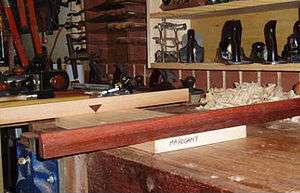Winding stick

In woodworking and carpentry, a pair of winding sticks is a tool that aids in viewing twist or wind in pieces of lumber (timber) by amplifying the defect.[1] Winding sticks can be as simple as any two straight sticks or they can be elegant, decorated, dimensionally stable wood like mahogany. A pair of framing squares may also be suitable. Traditionally they are 16 inches (41 cm)[1] to 30 inches (76 cm)[2] long 1.75 inches (4.4 cm) tall and tapered in their height from 3⁄8 inch (0.95 cm) to 1⁄8 inch (0.32 cm). The longer the winding sticks, the more they will amplify the wind. It is common for a woodworker to make a matching pair for the purpose, and contrasting colors of woods improve the discernability of differences in height and level between the two sticks as they are compared.
One winding stick is placed on one end of the piece and the second winding stick is placed on the other end, but parallel to the first. The woodworker then stands back a short distance and sights across the top of the two sticks. If the surface on which the sticks are sitting is flat (in the same plane), the top edges of the two sticks line up perfectly with each other; otherwise, the discrepancy becomes apparent. Adjustments to the surface of the board are then made (e.g., with a hand plane). This process is repeated all across the piece until the piece is satisfactorily true. Longitudinally the piece is checked with a straightedge.
References
- 1 2 Ellis, George. Modern Practical Joinery. London: B.T. Batsford, 1902. 51. Print.
- ↑ Holtzapffel, Charles. Turning and Mechanical Manipulation Intended as a Work of General Reference and Practical Instruction, on the Lathe, and the Various Mechanical Pursuits Followed by Amateurs. Vol. 2. London: Holtzapffel & Co., 1856. 500. Print.